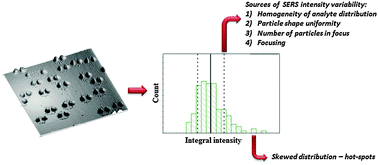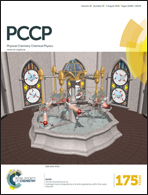Testing gold nanostructures fabricated by hole-mask colloidal lithography as potential substrates for SERS sensors: sensitivity, signal variability, and the aspect of adsorbate deposition†
Abstract
Gold nanoplasmonic substrates with high sensitivity and spectral reproducibility are key components of molecular sensors based on surface-enhanced Raman scattering (SERS). In this work, we used a confocal Raman microscope and several types of gold nanostructures (arrays of nanodiscs, nanocones and nanodisc dimers) prepared by hole-mask colloidal lithography (HCL) to determine the sources of variability in SERS measurements. We demonstrate that significant variations in the SERS signal can originate from the method of deposition of analyte molecules onto a SERS substrate. While the method based on incubation of SERS substrates in a solution containing the analyte yields a SERS signal with low variability, the droplet deposition method produces a SERS signal with rather high variability. Variability of the SERS signal of a single nanoparticle was determined from the statistical analysis of the SERS signal in short-range Raman maps recorded using different sized laser spots produced by means of different objectives. We show that the number of nanoparticles located within the laser spot can be a source of substantial SERS signal variability, especially for high-magnification objectives. We demonstrate that SERS substrates prepared by HCL exhibit high SERS enhancement and excellent homogeneity (about 20% relative standard deviation from short-range maps). The nanocone arrays are shown to provide the highest SERS enhancement, the lowest relative level of fluorescence background, and also slightly better homogeneity when compared with arrays of nanodisc dimers or single nanodiscs.


 Please wait while we load your content...
Please wait while we load your content...